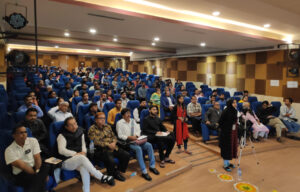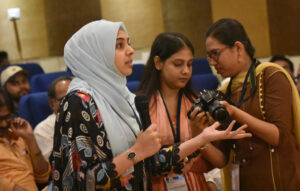Kolkata: Not many would know about the Hunter Commission set up by the British to prepare a report on why Indian Muslims were revolting against their regime, just like the Sachar Commission was asked to study the issues that plague the Muslims community. And after the report was filed, the British aligned with progressive Muslims and encouraged the community to embrace English education, unlike the governments of today, who are yet to act on the recommendation made by the Sachar Commission.
Also, many of us wouldn’t have also thought for a second, about the complete absence of Bengali Muslims in Bangla Films and serials. This comes as surprise, given the fact that Tollywood is considered as progressive, while the negligible presence of Muslims in government jobs in Bengal, no longer is a secret.
These and many more thought provoking topic was discussed for the first time in Kolkata, during a two-day international conference Bengali Muslims at a crossroad. The conference was organised by Aliah University in association with Bengali Academia for Social Empowerment (BASE) at the Park Circus Campus of Aliah University. The event had a number of Bengali Academics presenting their research papers to academically reclaim the lost status of the Bengali Muslim in both West Bengal and India.
Over 50 academic research were presented before the audience, covering issues like Unemployment among the Muslims in West Bengal, Representation of Bengali Muslims in Bangla Films in Contemporary West Bengal, A Peep into the Jenana Mehfil: Bengali Muslim Women and their Wedding Centric Songs, Faith, Food and YouTube: Bengali Muslim Identity and Food Videos During Eid in Kolkata, The Identity Crisis of Bengali Muslims (West Bengal): After Partition and more.
Dr Maidul Islam added, “During my on-going research, I was even amazed to see, even sensitive filmmakers like Satyajit Ray, Ritwik Ghatak and Tapan Sinha, have failed to the Bengali Muslims a decent place in Bengali Cinema.” Citing examples he said, “While Tapan Sinha’s film never had a Bengali Muslim character. Those who will remind me about Kabuliwala, need to understand, that the Kabuliwala was an Afghan Muslim and not a Bengali Muslim. Ghatak’s film made films on Hindu Bangladeshi refugees but chose to neglect the Bengali Muslim, while Ray, in his film Hirak Rajar Deshe had a character called Abu Fazal, who was a peasant.
Dr Maidul Islam, Centre for Studies in Social Sciences, Kolkata, presented an interesting paper, stressed upon – Representation of Bengali Muslims in Bangla Films in Contemporary Bengal. While presenting the paper, he said, “Post partition, Bengali Muslims have been conspicuously missing from Bengali Cinema. If you scan through the history of Bangla Films, you will see there are no films with Muslim characters as the protagonist. I call this phenomenon as Missing Muslims. Also, I have observed, during my research that Muslim characters if any in the film are increasingly being depicted as anti-social or terrorist. Also, there are specific stereotypes while representing Muslim characters. Like they must sport a beard and wear a skull cap.” Then he went on to add, “Such sketchy or biased representation only helps in creating a wrong perception about Muslims in general.”

He added, “During my on-going research, I was even amazed to see, even sensitive filmmakers like Satyajit Ray, Ritwik Ghatak and Tapan Sinha, have failed to the Bengali Muslims a decent place in Bengali Cinema.” Citing examples he said, “While Tapan Sinha’s film never had a Bengali Muslim character. Those who will remind me about Kabuliwala, need to understand, that the Kabuliwala was an Afghan Muslim and not a Bengali Muslim. Ghatak’s film made films on Hindu Bangladeshi refugees but chose to neglect the Bengali Muslim, while Ray, in his film Hirak Rajar Deshe had a character called Abu Fazal, who was a peasant.
The trend continues in present Tollywood cinema, where the filmmakers might introduce a Muslim character, but often they are non-Bengali Muslims. For example, Nandita Roy’s Haami had a Muslim character – Chacha Jaan, who was shown as skull cap-wearing, Hindi speaking Muslim. In Mishwar Rohoshyo, the Muslim character was an Egyptian Muslim, in Rajkahini, Rituparna Sengupta was Hindi speaking prostitute, while Kabir had a Muslim terrorist.”
According to Maidul, Hoi Choi Unlimited’s Azam Khan – a car mechanic, Mrinal Sen’s Amar Bhuban, Nobendu Chatterjee’s Monsur Miyaar Ghoda are some of the Bangla Cinema that can have been kind enough to give realistic celluloid representation to the Bengali Muslim.
Dr Mosarraph Hossain Khan, Assistant Professor, Department of English, Presidency University, drew a parallel between the present time and the 1870s when the British government commissioned the Hunter Commission, just like the decade-old Sachar Committee Report to understand what was making the Muslim to revolt against the regime. “It was after this report that the British aligned with the progressive Muslims and encouraged the community to embrace English education. However, post-partition, most of the Muslim intellectuals moved on to Pakistan and Bangladesh (East Pakistan). The Bengali Muslims who stayed back were poor and not intellectually sound and lacked a proper middle-class community. However, with time, a middle class is emerging among the Bengali Muslims who stayed back in India, when Partition happened. This is the right time for us to reclaim our identity.”
A similar presentation by Samiya Roshni, a PhD scholar from Vidyasagar University, tried to highlight the Representation of Muslims in Bengali Television Serials. “After the partition, in the post – Independence era, Bengali Muslims never acquired a prominent space on Bengali silver screen, unlike Hindi cinema where Muslims were represented adequately both on-screen and off-screen. And whenever Muslims were represented in the narrow cinematic space, they were depicted mostly as a marginalized section of the society. This representation is the outcome of certain cultural hegemony, religious identity and its power structure and market economy,” noted Samiya.
Meanwhile, Dr Mosarraph Hossain Khan, Assistant Professor, Department of English, Presidency University, drew a parallel between the present time and the 1870s when the British government commissioned the Hunter Commission, just like the decade-old Sachar Committee Report to understand what was making the Muslim to revolt against the regime. “It was after this report that the British aligned with the progressive Muslims and encouraged the community to embrace English education. However, post-partition, most of the Muslim intellectuals moved on to Pakistan and Bangladesh (East Pakistan). The Bengali Muslims who stayed back were poor and not intellectually sound and lacked a proper middle-class community. However, with time, a middle class is emerging among the Bengali Muslims who stayed back in India, when Partition happened. This is the right time for us to reclaim our identity.”

Sabir Ahamed, research coordinator of Pratichi, in his presentation Unemployment among the Muslims in West Bengal, chose to highlight, how even today, Bengal, despite its higher Muslim population, has very few Muslims as flag-bearers in government institutions. “Despite people accusing Mamata Banerjee of Muslim appeasement, I am unable to see its reflection in number of Muslims being employed in Government sector,” said Ahamed, while talking to eNewsroom.
He then went on to explain, “Look at the data revealed through one of my RTI application. The latest Staff Census of WB government shows percentage of Muslims employed in Government sector is as little as 5.3, 4.24, 2.66, in Kolkata, Howrah and Purulia, to name a few. I won’t deny that female recruitment has improved and so has the female percentage for higher education. But what about a huge chunk of Bengali Muslim men who migrate from Bengal on a regular basis, in search of better work? No data is being maintained by the government on the huge number of these Bengali Muslim men, who are drop outs.”
He then asserted, “There is a huge need for Bengali Muslim representation in Bengal Politics, and so is the need to increase the number of job openings. In KMC alone the percentage of Muslim appointment has shrunk to a mere 5.29 per cent in the year 2019.
Meanwhile, speaking to eNewsroom, Abdul Matin, treasurer, BASE and co-convener of the conference, said, “This is a way of academically recording the issues, problems or development of the Bengali Muslims in India and also to offer a platform to researchers, where they can present their academic findings.”
Courtesy: https://enewsroom.in/
 A speaker addresses the conference
A speaker addresses the conference